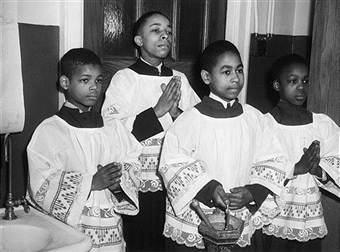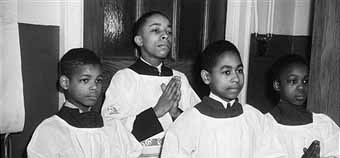 The title is not meant for everybody but for a few like me. It is just there to guide my thoughts but in the grand scheme of things it is also challenging to me.
The title is not meant for everybody but for a few like me. It is just there to guide my thoughts but in the grand scheme of things it is also challenging to me.
Patrick Mumbi, M.Afr
Recently, I gave a talk to the Missionary Oblate students and they chose the title; “Formation as Missionary oriented.” My talk centred on the mission of St Paul; “Being all things to all people” (1Cor 9: 19-23). For me this is the heart beat of missionary life and this is what I saw and moved me with the White Fathers 25 years ago even before I joined them. I observed and felt that they were sent to all people not only to the Catholics. St Paul’s mission of “becoming all things to all people” was modelled on Christ; the “Man of all seasons”. Just as Jesus Christ modified his life though he was God, St Paul too simplified his lifestyle, his preferences in order to win all for Christ. Adapting of one’s life and going an extra mile is not only a stepping stone for a great mission but also a fertilisation of Evangelisation for people to come to Christ. We sometimes laugh about Father Joseph Dupont nicknamed as Motomoto becoming the husband to the wives of Paramount Chief Mwamba but how many people did he win for Christ? Actually, the story is that when Chief Mwamba was probably dying around 1899 he gathered his counsellors and handed over his wives and the kingdom to Motomoto. Is this not the origin of the famous book, “Roi de Brigands”? Around 1898 in Chilubula area, Motomoto had already established friendship with Chief Mwamba unlike his father Paramount Chief Chitimukulu who did not consent to the White Fathers settling in his Kingdom.
Having the spirit of being all things to all people, missionaries were washing the wounds of people and bandaging them, giving injections and pills. At times their cars acted as ambulances because they would be awakened at night to take the sick and pregnant women to the main hospitals. I am pretty sure all these helped people to listen and become more open to receive the Good News. In my conception, there is no cut and dried priesthood or sisterhood. Priesthood is a tool through which one can propagate and accomplish the mission of Christ. Evangelisation is an archetype concept such that at every stage of human life it has to be reinvented. Archetypes like the Evangelisation of Africa which our Cardinal Lavigerie conceived, emerged from the human psyche. The word “evangelist” comes from the Greek word εὐαγγέλιον (transliterated as euangelion) via latinised evangelium. The Greek word εὐαγγέλιον originally meant a reward given to the messenger for good news (εὔ = “good”, ἀγγέλλω = “I bring a message”; the word “angel” comes from the same root and later “good news” itself (Class notes of scripture 1991). Archetypes are the formative templates that give breath (inspire) and depth (materiality) to events in the outer world (Carl Jung’s archetypes 1959). In certain individuals like our Cardinal, events or history prepare themselves; and when the archetypes are activated in a number of individuals and come to the surface, we are in the midst of history, as we are at present. Missionaries were seized by this archetype of evangelising of Africa and therefore packed their bags 150 years ago.
 Commitment to Christ’s mission: This commitment was very important for missionaries. Probably this is the reason why they worked tirelessly. This commitment and courage continued even when others perished, and the energy to work hard every day, is what impressed some of us and got the vocation to join them 25 years ago. This year in 2016, I celebrated my 25 years of priesthood in Luena parish and Jack compound in Lusaka. But concerning mission, do we as young missionaries have the zeal and commitment to work extra miles today as they did? As altar boys, we were visiting outstations with missionaries for months during holidays. With them we conducted catechumen classes, helped to carry out marriages and house to house visitations etc. For some of us young missionaries, going to an outstation is like a punishment. The only thing we would wish is to go back to the parish as quickly as possible. But in those days, touring and knowing people, registering them in books were taken as evangelisation. Bringing happiness and fulfilment were some of the other attributes of missionaries to the people they evangelised.
Commitment to Christ’s mission: This commitment was very important for missionaries. Probably this is the reason why they worked tirelessly. This commitment and courage continued even when others perished, and the energy to work hard every day, is what impressed some of us and got the vocation to join them 25 years ago. This year in 2016, I celebrated my 25 years of priesthood in Luena parish and Jack compound in Lusaka. But concerning mission, do we as young missionaries have the zeal and commitment to work extra miles today as they did? As altar boys, we were visiting outstations with missionaries for months during holidays. With them we conducted catechumen classes, helped to carry out marriages and house to house visitations etc. For some of us young missionaries, going to an outstation is like a punishment. The only thing we would wish is to go back to the parish as quickly as possible. But in those days, touring and knowing people, registering them in books were taken as evangelisation. Bringing happiness and fulfilment were some of the other attributes of missionaries to the people they evangelised.
 Availability to the people of God: The Parish Office was open from Sunday to Sunday. Unlike today, we open when people come to knock at our doors then quickly close them saying; “we do not have time or we do not want to be bothered”. When I was young, I saw that when one priest went out of the Parish Office, another one entered in to attend to the people. It reminded me of the film of Bruce Lee: “Exit Dragon Enter the Tiger.” They were serious and firm as any other priest found in the parish office when it comes to matters of faith. When someone enters the office they would enquire if he or she received all the sacraments. I must also acknowledge that they were of different temperaments; some moderate while others were hard. Some of them preached with passion such that children would get afraid and begin to cry out.
Availability to the people of God: The Parish Office was open from Sunday to Sunday. Unlike today, we open when people come to knock at our doors then quickly close them saying; “we do not have time or we do not want to be bothered”. When I was young, I saw that when one priest went out of the Parish Office, another one entered in to attend to the people. It reminded me of the film of Bruce Lee: “Exit Dragon Enter the Tiger.” They were serious and firm as any other priest found in the parish office when it comes to matters of faith. When someone enters the office they would enquire if he or she received all the sacraments. I must also acknowledge that they were of different temperaments; some moderate while others were hard. Some of them preached with passion such that children would get afraid and begin to cry out.
The spirit of service: White Fathers were servants of God and peoples. They served them with humility. They not wait for people to come but they would go to the people so as to know them better. I knew some White Fathers who used to come to our village to drink beer such as Fr Cletus Gerrie van Erp and Fr Anton Buys. They did so as to familiarise themselves with the people and get to the grips of their culture. The whole village became Catholics. Even individuals who claimed to be from some other churches joined Catholicism.
The new mushrooming churches I have seen was a later phenomenon when White Fathers had left. I would like to acknowledge that the evangelised people became evangelisers of the Copperbelt and some parts of Zambia because these were properly catechised. In the 1930s, when the Italian Franciscans came to the Copperbelt at the beginning of mining, they found groups of young men and women from the Northern Zambia and Luapula already praying on Sunday morning. It was easier for them to form Parishes.
The casualisation of mission: Nowadays we are witnessing the casualisation of evangelisation even that of the priesthood. There is nowadays lack of seriousness in studying the language. The feature of not knowing the language and needing an interpreter is a recent thing. Besides, if one spends the whole night on the Internet watching one movie after another, would one have the energy next morning to go and work in the outstation? Nowadays there are vices such as overdrinking, priests befriending nuns and lack of prayer life, etc. I was once asked by parishioners the following; “when Father so and so was here, he used to read a little prayer book and saying the rosary while walking up and down, and you, do you also have that little book and do you say the rosary”? Ah, hum.
Zeal for the mission: Early missionaries were pastoral people and were filled with zeal for the mission. Do we have that pastoral zeal today? Where are our hearts? Ubulimi bwakale tababutalalikishako mwana; “My child stop crying of hunger, I used to be a good farmer with plenty of food,” meaning “you cannot at all times glory in the past successes”. We need to reinvent ourselves in this age. We need to be thinkers and reflectors about today’s mission which is a challenge, otherwise we shall be redundant. This is the reason why I said that evangelisation is an archetype concept and if we do not meditate on it we shall find ourselves outdated when actually the sky is the limit when it comes to evangelisation. Nowadays there are challenges in social life, worrying African politics, poverty of Africa, refugees. What would be our contribution to all these?

Koma, mwa kamba zoona.
Pitirizani, osaopa.
Mulungu akudalitseni.
Ndinayamba kupunzira cicewa m’caka 1951
Mundipempherere kuti Mulungu andi landire mwa msanga.
Pingback: A ‘Finale’ on 125 Years of Catholic Faith in Zambia – July 15, 2017. – Missionaries of Africa – SAP Province